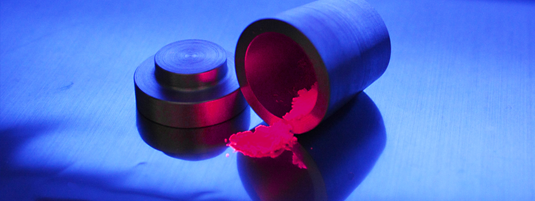In cooperation with Dr. Peter Schmidt of Philips Technologie GmbH in Aachen, a team of researchers led by Prof. Dr. Wolfgang Schnick, who holds the Chair of Inorganic Solid-State Chemistry at LMU Munich, has developed a new material for application in light-emitting diodes (LEDs). “With its highly unusual properties, the new material has the potential to revolutionize the LED market,” says Schnick. The two teams report their results in the latest edition of Nature Materials.
 |
|
The newly developed phosphor enhances the quality of color rendition by white-emitting LEDs. Source: Professor Wolfgang Schnick, LMU Munich |
Conventional incandescent light bulbs have a very low energy conversion efficiency, which has led the EU to order their withdrawal from the market. As a result, light-emitting diodes (LEDs) have become the light source of choice for the foreseeable future. The light emitted by LEDs is generated by electronic transitions in solid-state semiconductors. In contrast to so-called energy-saving lamps, which contain toxic mercury, LEDs are environmentally friendly. Moreover, they are highly efficient and promise significant reductions in energy consumption.
A single LED can produce light of only one color tone. However, Schnick and his team had previously achieved a notable technological breakthrough by synthesizing innovative phosphor materials that allowed the blue light produced by conventional LEDs to be converted into all the colors of the visible spectrum – in particular, those at the red end. Mixing of the different colors results in high-quality white light and this invention earned Schnick and his colleagues a nomination for the German Future Prize 2013.
A new material with great potential
LEDs that generate blue light can be converted into white-light emitters by coating them with various luminescent ceramics. These materials absorb some of the blue light and re-emit the energy at wavelengths corresponding to all the other colors of the visible spectrum from cyan to red. The combination of these color components with the unabsorbed blue light results in pure white light. The process sounds simple, but its practical realization is very challenging. It requires phosphors which display extremely high thermal stability and operate with very high efficiencies.
“The problem with commercially available white-light LEDs is that there is always a trade-off between optimal energy efficiency and acceptable color rendition” says Schnick. The red-emitting phosphor materials so far used are the principal factor responsible for this, because they have a particularly significant influence on the so-called color rendering index. There is also a growing demand in the industrial sector for new phosphors capable of emitting in the deep-red region because this would enable the conflicting demands of optimal efficiency and most natural color rendition to be reconciled.
The new material developed by Schnick, Schmidt and their colleagues is based on the nitride Sr[LiAl3N4]. When doped with an appropriate amount of europium, a rare-earth metal, the compound displays intensive luminescence over a very narrow range of frequencies in the red band. Peak emission occurs at wavelengths of around 650 nm and peak width (full width at half-maximum) is only 50 nm. The first prototype LEDs incorporating the new material generate 14% more light than conventional white-light LEDs and have an excellent color rendering index. “With its unique luminescence properties the new material surpasses all red-emitting phosphors yet employed in LEDs and has great potential for industrial applications” Schnick concludes.
Dr. Peter Schmidt and his associates at the Lumileds Development Center Aachen (Philips Technologie GmbH) are currently modifying the synthesis of the new red phosphor to optimize it for large-scale manufacture. Their goal is to open the way to the next generation of brighter and more efficient white-emitting LEDs with the best possible color rendition characteristics.












